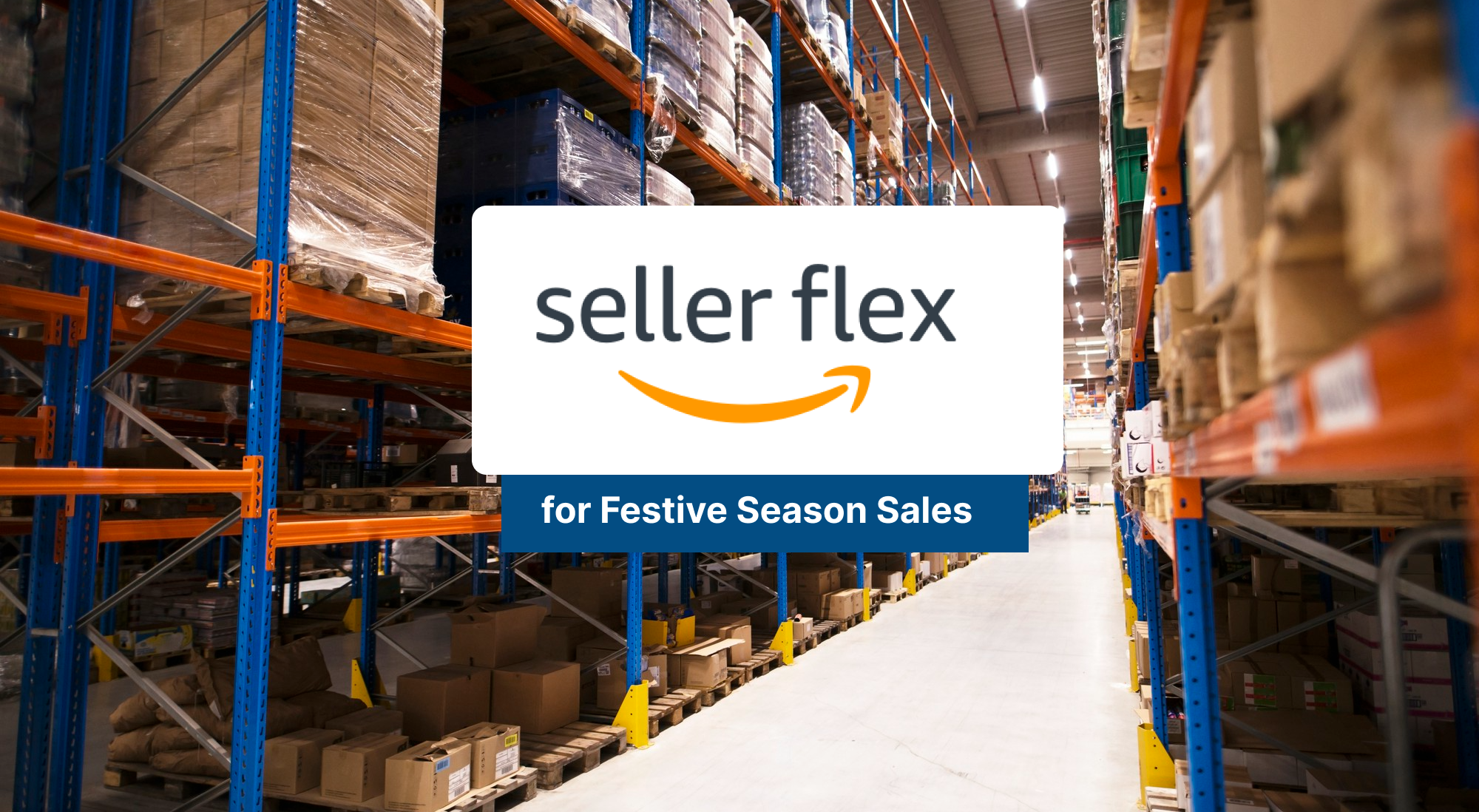Navigating Festive Season Sales: Overcoming Challenges with Amazon FBA Through Seller Flex

For Indian sellers, the festive season is the most crucial period of the year, with festivals like Diwali driving a significant portion of annual sales—almost 30-50% for most brands. However, this season presents an enormous opportunity but also a unique set of challenges, particularly for those relying on Amazon’s Fulfillment by Amazon (FBA) service. Limited appointment slots, storage capacity restrictions, and unpredictable cost surges are common issues that can hamper a seller’s ability to keep up with high demand during this peak period.
The Challenges with FBA
As the festive season approaches, sellers across India are gearing up for an influx of orders on Amazon. However, many face significant challenges with Amazon’s FBA service, including difficulties securing appointments and strict storage rate limits. Sellers increasingly find it difficult to secure FBA appointment slots, which are either unavailable or offered too late. This prevents them from building up sufficient inventory in key demand centers. Compounding this issue, Amazon’s recent implementation of storage rate limits restricts the amount of inventory sellers can store, leading to early stockouts even before the sales season peaks.
The Importance of Regional Inventory
Amazon’s algorithm gives preference to regionally available inventory to compete with quick-commerce platforms that offer rapid delivery. Products with regional stock are more likely to be featured prominently in search results, making regional inventory crucial for maintaining visibility and sales during peak periods. Sellers relying solely on national availability might find their products pushed to the back pages, significantly impacting their sales during the festive season.
Exploring Alternative Fulfillment Models
Given the limitations of FBA, it’s essential for sellers to explore alternative fulfillment models. Amazon offers two primary fulfillment models: Amazon-managed (including FBA and Multi-Seller Flex) and Seller-managed (including Seller Flex, Easy Ship, and Self Ship). Each model has its pros and cons, depending on a seller’s specific needs, such as control over warehouse operations, access to Prime benefits, and management of returns and claims.
Also check : 10 Best Amazon FBA Alternatives
Seller Flex: A Tailored Solution for Indian Sellers
With the Seller Flex windows currently open, Indian sellers have a timely opportunity to mitigate these challenges by opting for Amazon’s Seller Flex model. Seller Flex offers a hybrid solution that provides greater control over fulfillment operations while still allowing sellers to benefit from Amazon’s Prime badge, which includes boosted visibility and fast, Prime-eligible shipping.
Seller Flex allows sellers to manage their inventory within third-party fulfillment centers, offering more consistent access to fulfillment slots compared to traditional FBA. This consistency reduces the risk of stockouts, enabling sellers to maintain adequate inventory levels throughout the festive season. Additionally, Seller Flex helps avoid the surge pricing and storage limits that are common with FBA during peak sales periods, providing both financial and operational stability.
Benefits of Seller Flex
Seller Flex stands out as a compelling alternative to FBA, particularly for sellers looking to maintain the Prime tag benefits while managing their fulfillment processes. Unlike Easy Ship and Self Ship, Seller Flex offers the same algorithmic boost and Prime privileges as FBA, making it an attractive option for sellers aiming to maintain high visibility and fast delivery times.
One of the significant advantages of Seller Flex for Indian sellers is the enhanced visibility it provides. Amazon’s algorithms tend to prioritize products that are regionally placed, giving a competitive edge to sellers who utilize Seller Flex. By strategically placing inventory in key regions across India, sellers can increase their product’s discoverability, leading to higher sales.
Furthermore, Seller Flex offers easier scalability, crucial for handling the increased sales volumes typical of the festive season. Sellers can leverage Amazon’s or WareIQ’s extensive pan-India fulfillment network to scale their operations quickly and efficiently. This flexibility ensures that sellers can expand their reach across India without the logistical challenges that often come with rapid growth.
In summary, Seller Flex benefits sellers through the following offerings:
- Prime Badge to boost product visibility on Amazon
- Easy scale-up through WareIQ’s pan-India fulfillment network
- No returns claims / SAFE-T claims management hassle as it is managed by WareIQ
- FC Appointments are available every week for all demand centers with WareIQ
- No surge pricing or storage limits during peak sales
- Common inventory pool to fulfill orders coming from multiple channels leading to higher inventory turnover
- Easier and quicker processing of removal orders
Suggested read: Amazon FBA Capacity Limits [2025]
Activating Seller Flex
To activate Seller Flex, sellers must first ensure their brand meets Amazon’s eligibility criteria. If approved, the next step is to partner with a third-party logistics provider that is Seller Flex compliant. It’s crucial to identify the key demand centers for your products and select a partner with a strong presence in those areas. Additionally, sellers must complete the necessary GST registrations for each location—a process that can take time, so it’s important to start early.
WareIQ, for instance, offers a robust network of compliant warehouses across India, helping sellers build up inventory without the challenges associated with FBA. The service also supports sellers with GST approvals and provides tools for automating inventory operations, SKU redistribution, and managing returns, ensuring a smooth and efficient fulfillment process.
How Seller Flex Works with WareIQ?
Working with WareIQ to activate Seller Flex is a streamlined process designed to optimize your operations and ensure you’re ready for the festive season. Here’s how it works:
- Step 1: Send Inventory: Send your products to WareIQ’s regional FC
- Step 2: Pan-India Placement: We distribute inventory to optimal locations in our pan-India network ensuring high discoverability & delivery speed
- Step 3: Inventory Operations Automation: Automate inventory restocking and redistribution and excess removal for FBA and WareIQ FCs
- Step 4: Prime-eligible Deliveries: Our team picks, packs, and dispatches orders accurately on time
How can WareIQ help?
WareIQ offers a comprehensive solution for sellers looking to activate Seller Flex and overcome the limitations of FBA, particularly during high-demand periods like the festive season.
- With a robust network of compliant warehouses across India, WareIQ helps sellers build up inventory in key demand centers, ensuring they are well-prepared for peak sales.
- The service also supports sellers with GST approvals and provides advanced tools for automating inventory operations, SKU redistribution, and managing returns.
- By partnering with WareIQ, sellers can navigate the complexities of fulfillment, maintain Prime benefits, and optimize their regional inventory to maximize their sales potential during the most critical times of the year.
Watch this Quick Video to Learn More on Activating Seller Flex for Festive Season
How to Enhance Your Amazon FBA Experience with WareIQ’s Seller Flex Services?
Sellers are continually seeking ways to optimise their operations and enhance customer satisfaction. While Amazon FBA (Fulfillment by Amazon) offers a streamlined approach to logistics, integrating WareIQ’s Seller Flex services can provide an additional layer of flexibility and efficiency that can significantly improve your selling experience.
- The Importance of Timely Deliveries
Meeting delivery appointments is crucial for the success of any seller using Amazon FBA. Delays can disrupt the entire fulfilment process, leading to frustrated customers and potential losses in sales. This is where WareIQ’s Seller Flex services come into play. By allowing sellers to manage their own inventory and fulfilment processes, Seller Flex helps ensure that products are delivered on time, every time.
- Streamlined Inventory Management
WareIQ’s Seller Flex allows sellers to maintain greater control over their inventory. Unlike traditional FBA, where inventory is sent to Amazon’s fulfilment centres, Seller Flex enables sellers to utilise their warehouses or WareIQ warehouses. This flexibility means that sellers can respond more swiftly to changes in demand, ensuring that stock levels are optimised and that products are always available for prompt dispatch.
- Enhanced Fulfilment Precision
The precision of fulfilment is paramount in maintaining customer loyalty. With WareIQ’s Seller Flex, sellers can strategically place inventory in crucial locations, reducing shipping times and ensuring that products reach customers quickly. This proactive approach enhances the customer experience and aligns with Amazon’s commitment to fast and reliable delivery.
- Proactive Appointment Management
Scheduling delivery appointments is a critical aspect of the FBA process. WareIQ’s Seller Flex services simplify this by providing tools and insights that help sellers plan shipments more effectively. By leveraging advanced analytics and automated scheduling, sellers can secure delivery slots that align with their operational needs, reducing the risk of missed appointments and the associated penalties.
- Building Customer Trust and Loyalty
In e-commerce, timely deliveries are essential for building customer trust and loyalty. By integrating WareIQ’s Seller Flex with your Amazon FBA strategy, you can ensure that your customers receive their orders on time, especially during peak seasons or special occasions. This reliability fosters positive customer experiences, encouraging repeat business and favourable reviews.
Incorporating WareIQ’s Seller Flex services into your Amazon FBA operations can significantly enhance your fulfilment strategy. By providing greater control over inventory, improving delivery precision, and streamlining appointment management, Seller Flex empowers sellers to meet customer expectations consistently.
Suggested read: Amazon Seller Flex Windows Reopening Next Week of January 2025








